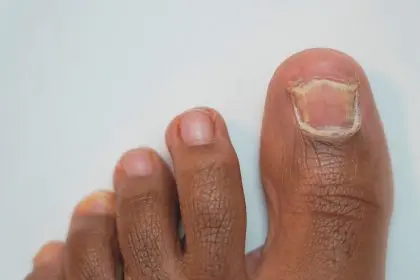That little dent in the middle of your stomach isn’t just a quirky reminder of your time in the womb, it’s potentially one of the most bacteria-packed spots on your entire body. Your belly button is like a warm, moist cave that provides the perfect breeding ground for microorganisms you definitely don’t want setting up permanent residence in your body.
Most people treat their belly button like it’s just decorative, maybe giving it a quick swipe with a washcloth during showers without really thinking about what might be lurking in there. But that innocent-looking navel could be harboring infections, fungal overgrowth, and bacterial colonies that are affecting your health in ways you never connected to that overlooked body part.
The scary part is how symptoms from belly button infections can masquerade as other health problems, sending you on wild goose chases trying to figure out why you feel unwell while the real culprit is hiding in plain sight right on your abdomen. Your belly button might be the missing piece of the puzzle for mysterious health issues you’ve been struggling with.
Why your belly button becomes a bacterial paradise
Your navel is essentially a skin fold that creates the perfect storm of conditions for microorganisms to thrive. It’s warm, often moist from sweat, and typically receives minimal cleaning attention, making it an ideal environment for bacteria, yeast, and other microbes to multiply rapidly.
The shape of your belly button matters more than you might think. Deep navels, particularly “innie” belly buttons, create shadowy recesses where dead skin cells, soap residue, lint, and other debris can accumulate. This organic matter becomes food for bacteria, allowing them to establish thriving colonies that can persist for months or years.
Your belly button doesn’t have the same self-cleaning mechanisms as other parts of your body. Unlike your mouth which has saliva, or other areas that benefit from regular movement and air circulation, your navel sits in a relatively stagnant microenvironment where problematic microorganisms can flourish undisturbed.
The bacteria living in your belly button aren’t necessarily the same as those found elsewhere on your skin. This unique ecosystem can harbor species that are particularly good at surviving in low-oxygen environments, including some that can cause infections when they overgrow or spread to other areas of your body.
The warning signs hiding in your navel
A persistent bad smell coming from your belly button is often the first sign that something bacterial is brewing down there. This isn’t the normal slight body odor you might expect from any skin fold, but rather a distinctly unpleasant, sometimes fishy or cheesy smell that doesn’t go away with regular washing.
Discharge from your belly button should never be ignored, whether it’s clear, yellow, green, or bloody. Any fluid coming from your navel indicates that something is seriously wrong, possibly including bacterial infection, yeast overgrowth, or in rare cases, more serious internal issues that require immediate medical attention.
Itching, burning, or pain around your belly button can signal that harmful microorganisms have irritated the sensitive skin in that area. These symptoms might start mild but can progressively worsen as infections establish themselves and spread to surrounding tissues.
Changes in the appearance of your belly button, such as redness, swelling, or the development of a rash, indicate inflammation that’s often caused by bacterial or fungal infections. The skin around an infected navel might also feel warm to the touch or appear shiny and tight.
The shocking variety of bugs living in your button
Your belly button can harbor an astonishing diversity of microorganisms, including bacteria species that are normally found in soil, water, and other environmental sources. Some people’s navels contain bacteria that are more commonly associated with hospital-acquired infections, suggesting that belly buttons can pick up and retain dangerous microbes from various sources.
Staphylococcus bacteria, including antibiotic-resistant strains, commonly colonize belly buttons and can cause serious infections if they spread to other parts of the body through small cuts or scratches. These bacteria can lie dormant in your navel for extended periods before causing problems.
Fungal infections, particularly those caused by Candida species, love the warm, moist environment of belly buttons. These yeast infections can create persistent itching, discharge, and odor while potentially affecting your immune system’s ability to fight off other infections.
Some belly buttons harbor bacteria that produce toxins or inflammatory compounds that can affect your overall health. While these microorganisms might not cause obvious local symptoms, they could contribute to systemic inflammation or immune system dysfunction that manifests in seemingly unrelated health problems.
How belly button bacteria mess with your whole body
Chronic low-grade infections in your belly button can trigger systemic inflammation that affects your energy levels, mood, and overall sense of well-being. Your immune system might be constantly working to keep belly button bacteria in check, leaving you feeling tired and run-down without understanding why.
The inflammatory response to belly button infections can affect your digestive system, potentially contributing to bloating, gas, or other gastrointestinal symptoms that seem unrelated to a problem in your navel. The proximity of your belly button to your abdominal organs means that inflammation in this area can have widespread effects.
Bacterial toxins produced by microorganisms in your belly button can enter your bloodstream and affect your liver’s detoxification processes. This could contribute to feelings of sluggishness, brain fog, or difficulty concentrating that you might attribute to stress or lack of sleep.
Some people develop skin problems elsewhere on their body due to belly button infections, as bacteria or fungi spread from the navel to other areas or trigger immune responses that affect skin health generally. Eczema, rashes, or persistent acne might sometimes be traced back to overlooked navel infections.
The belly button-immune system connection
Your belly button sits very close to important lymphatic drainage pathways and blood vessels that connect to your immune system. Chronic infections in this area can overwhelm local immune defenses and potentially affect your body’s ability to fight off other infections or maintain optimal health.
The constant immune activation required to control belly button bacteria can contribute to autoimmune problems in susceptible individuals. Your immune system might become confused by the constant presence of foreign microorganisms and start attacking your own tissues, leading to various autoimmune symptoms.
Belly button infections can serve as a reservoir for antibiotic-resistant bacteria that can spread to other parts of your body during times when your immune system is compromised by illness, stress, or other factors. This hidden bacterial reservoir could make you more susceptible to serious infections.
The inflammatory cytokines produced in response to belly button infections can affect your sleep quality, hormone production, and mental health. What seems like a minor local infection could be contributing to insomnia, mood swings, or other systemic health problems.
Why doctors often miss belly button problems
Most healthcare providers don’t routinely examine belly buttons during regular checkups, meaning that significant infections or abnormalities can go undetected for years. Unless you specifically mention belly button symptoms, your doctor probably isn’t looking at or thinking about this area as a potential source of health problems.
Belly button symptoms are often vague and can mimic other conditions, leading to misdiagnosis or overlooked infections. That persistent fatigue or mysterious rash might never be connected to your navel because the symptoms seem unrelated to such a small, seemingly insignificant body part.
Many people are embarrassed to mention belly button problems to their healthcare providers, especially if there’s discharge or odor involved. This reluctance to discuss navel issues means that potentially serious infections remain untreated and continue affecting overall health.
The medical training focus on major organ systems often overlooks the potential health impact of seemingly minor areas like belly buttons. Healthcare providers might not consider the belly button as a possible source of systemic health problems, leading to lengthy diagnostic processes that never identify the real culprit.
Hidden risks that make belly button care crucial
People with diabetes, compromised immune systems, or other chronic health conditions are at higher risk for serious belly button infections that can spread to deeper tissues or enter the bloodstream. What might be a minor problem for healthy individuals could become life-threatening for vulnerable populations.
Belly button piercings create additional risks by introducing foreign objects that can harbor bacteria and prevent proper healing. Even well-healed piercings can develop infections years later, and the presence of jewelry makes thorough cleaning more difficult.
Obesity can create deeper skin folds around the belly button, making it even more difficult to clean properly and creating conditions where dangerous bacteria can thrive undetected. The increased skin contact and reduced air circulation in these deeper folds compounds infection risks.
Certain medications, particularly antibiotics and immunosuppressive drugs, can alter the bacterial balance in your belly button and allow harmful microorganisms to overgrow. People taking these medications should pay extra attention to belly button hygiene and watch for signs of infection.
Simple strategies to protect your navel health
Daily cleaning of your belly button with soap and water, followed by thorough drying, can prevent most bacterial and fungal overgrowth. Use a cotton swab or washcloth to gently clean inside the navel, but avoid aggressive scrubbing that could create small wounds where bacteria can enter.
Keeping your belly button completely dry after showers or swimming is crucial for preventing fungal infections. Consider using a hair dryer on a cool setting to ensure complete drying, especially if you have a deep navel or live in a humid climate.
Wearing loose, breathable clothing allows air circulation around your belly button and reduces moisture buildup that promotes bacterial growth. Tight clothing or synthetic fabrics can trap heat and moisture, creating ideal conditions for harmful microorganisms.
Regular inspection of your belly button for changes in appearance, smell, or sensation can help you catch problems early before they become serious infections. Take photos if you notice anything unusual so you can track changes over time and show them to healthcare providers if needed.
When your belly button demands medical attention
Any discharge, persistent odor, or pain in your belly button should prompt a medical evaluation, especially if these symptoms don’t improve with improved hygiene practices. These could indicate serious bacterial infections that require antibiotic treatment or other medical interventions.
Signs of spreading infection, such as red streaks extending from your belly button, fever, or swollen lymph nodes, require immediate medical attention. These symptoms suggest that bacteria have entered your bloodstream or lymphatic system, creating a potentially dangerous situation.
If you have diabetes, immune system problems, or other chronic health conditions, even minor belly button symptoms should be evaluated promptly by a healthcare provider. What might be manageable for healthy individuals could become serious complications for people with underlying health issues.
Your belly button deserves better attention
That little indentation in your abdomen is more than just a biological curiosity, it’s a potential gateway for infections that could be affecting your health in ways you never imagined. Taking belly button hygiene seriously isn’t vanity, it’s an important part of maintaining your overall health and preventing problems that could impact your entire body.
Your belly button has been with you since birth, quietly collecting bacteria and potentially causing health problems that fly under the radar of conventional medical care. It’s time to start treating this overlooked body part with the attention and care it deserves.
The next time you’re in the shower, remember that your belly button needs just as much cleaning attention as any other part of your body, maybe more. Your overall health might depend on keeping this small but potentially problematic area clean and healthy.















